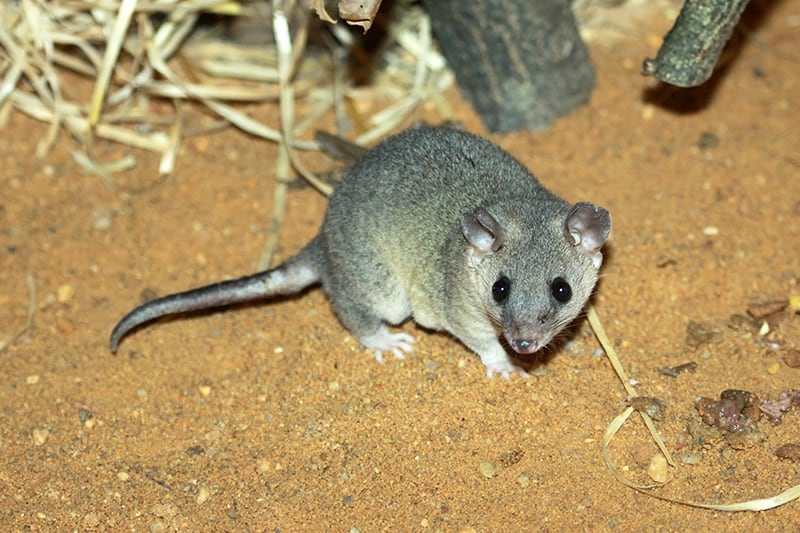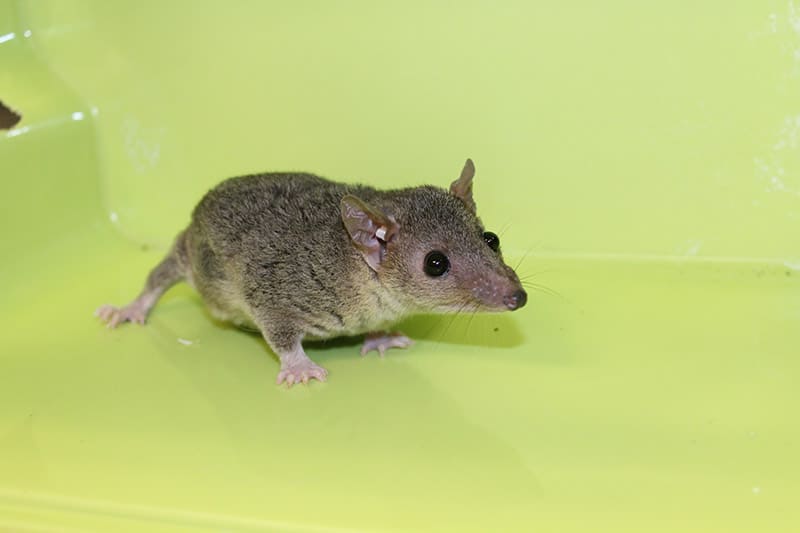Not only is the exotic Short Tailed Opossum very small, but it has a curious and easy-going nature… they are becoming quite a popular “pocket pet”!
Short Tailed Opossums, also referred to as STO’s, are small and very cute. They make unique and fascinating pets. If handled at an early age they are easy to tame and become very friendly. They usually do not bite and are very easy to keep., you can even train them to use a litter box. They are solitary animals however, and should be kept singly as they tend to fight with other opossums when they reach maturity.
Because of their nature and uniqueness, the Short Tailed Opossums make excellent pets. They are quiet, active, and inquisitive, and since opossums are not rodents they generally don’t gnaw on things. A special bonus to keeping a Short Tailed Opossum, they will eat unwelcome pests such as insects and rodents. Because of this they are sometimes referred to as “House Opossums”. They are generally nocturnal, getting active at dusk which is great for people who have the evening hours to interact with their pet. If they are awakened during the day though, they will venture out and be social.
The Short Tailed Opossum belongs to the order marsupialia. Unlike many marsupials, the Short Tailed Opossum does not have a pouch. They have a unique adaptation in caring for their young. New born babies will latch onto a nipple on their mother’s stomach which then enlarges and holds the babies securely in place.
There are a variety of marsupials including such creatures as kangaroos, Sugar Gliders, Wombats, Ringtail Possums, and Tasmanian Devils.
- For information about Small Animals and their care visit: Guide to a Happy, Healthy Small Animal
Scientific Classification
| Kingdom: | Animalia |
| Phylum: | Chordata |
| Class: | Mammalia |
| Order: | Didelphimorphia |
| Family: | Didelphidae |
| Genus: | Monodelphis |
| Species: | domestica |
Scientific Name:
Background
The Short-Tail Opossum is found mainly in Brazil and adjoining countries of Bolivia, Paraguay, and Chile and there are 17 different species. The Monodelphis domestica, described here, was imported into the United States from Brazil in 1978 by the National Zoo and introduced into the pet market in 1994. Brazil has now closed their borders to exportation, so those available for pets are all bred in captivity.
In their native countries they live close to humans and are frequently found living in houses. Natives call them “cachita” and consider them to be good luck. They readily welcome them as they have a great appetite for unwanted pests such as insects, rodents, and even scorpions.
Note: Opossums are NOT the same thing as possums. “Opossums” range from North America to southern Argentina and contain 15 genera with over 60 species. “Possums” are found in Australia with over 20 species. They are both marsupials, but are actually only distantly related within the same subclass.
Description
A mature Short Tailed Opossum will reach a body length of about 4″ – 6″ (10 – 15 cm) with a tail that is about 1 1/2″ – 3″ (4 – 7.5 cm) and will weigh between 2 – 5 ozs (60 – 150 g). The males are about 25% larger than the females.
The fur is a thick velvety gray-brown on top with a lighter tone underneath. They have a hairless prehensile tail used to grasp and balance while climbing. It is also great for carrying nesting materials and other things, but it is not weight bearing. They have a muzzle quite like a rat, with very sharp teeth. Their ears are large, very thin skinned, and sensitive to sound and their eyes bulge out giving them good night vision. The front legs are shorter than the hind legs. They have a life span of about 4 to 8 years.
Babies are born premature, pink, and hairless. They are helpless, latching on to a nipple on their mothers stomach where they will stay until they are further developed.

Environment
The Short Tailed Opossum is an escape artist, and must be kept in a secure enclosure. A 10 gallon or larger aquarium with a secure lid or a narrow-mess wire cage work well. Provide corn cob, Care Fresh litter, or shavings (though not cedar) for bedding and a nest box with some nesting materials such as cotton or shredded paper.
For exercise and entertainment, they will need things to climb on such as branches, ropes, or parrot ladders, and you can also give them a small hamster wheel. For some fun you can include such things as clay flowerpots, PVC tubes, and other places for them to hide. They need a draft free warm environment. Keep the temperature between 68° – 88° F. and at least a 50% humidity, a little on the warmer side is best for mothers with babies.
They are neat clean little critters and will usually pick a corner of their enclosure for a bathroom. They can even be trained to use a litter box, which makes cage cleaning much easier. Short Tailed Opossums are basically odor-free and their cage only needs to be cleaned about once a week.
Care and feeding
Provide your Short Tailed Opossum with fresh water daily in a water bottle. For younger opossums that are not too strong, one without a steel ball works best.
In the wild they eat insects, fruits, and vegetable matter. You can provide them a similar diet by offering mealworms, crickets, pinkie mice, fruits, vegetables, and breads.
You can also offer them high-quality cat food, other dry foods such as a ferret food, or a commercially developed food called Briskey’s Short Tail Possum feed. Supplement these by offering treats of crickets or mealworms a couple times a week as well as small amounts of fruits and vegetables.
Other treats can include such things as super worms, hard boiled egg, scrambled egg, tuna, canned cat food, and fresh fruits and vegetables. Fresh fruits need to be cut up into small pieces so they can pick them up easily. Some quick and easy fruit options are the small Mott’s Applesauce; Mixed Berry, Strawberry, or Tropical Blend fruit cups; or baby foods.
Social Behaviors
A Short Tailed Opossum can become a friendly docile pet that can easily be handled by people and is curious, active, and entertaining.
Because they are naturally solitary animals, they should be housed individually. The only time they should be put together with other opossums is when they are being bred, and then for only a short time. Cage mates will eventually become aggressive toward one another, possibly killing each other. Young opossums should be housed separately by the time they reach 9 weeks of age.
Handling and Training
If handled from a young age, a Short Tailed Opossum can become a loving gentle pet that generally will not bite. A good age to acquire your pet is between 3 and 4 months of age, though even some adults will adjust to being handled. They are friendly and inquisitive. Both males and females make equally good pets.
Activities – Exercise and Play
The Short Tailed Opossum is nocturnal, meaning it is active at night. Be sure to give it lots of things to climb and perch on, such as branches, parrot ladders, and ropes. They will also enjoy a hamster wheel to run on.

Breeding/Reproduction
Short Tailed possums are sexually mature at about 4 to 5 months of age. They will breed in any season, and can have up to 4 litters a year. When you introduce a pair, only keep them together for about 12 days.
The gestation period is about two weeks and the female will have a litter size of up to about 13 babies. Unlike most marsupials, the female does not have a pouch so the newborn babies, pink and hairless, will firmly attach themselves to a nipple on their mother’s stomach. The mother will spend the majority of her time in the nest. At about 4 weeks of age, they young will begin to wander about the nest. They will cling to the fur on their mothers back and ride around with her whenever she leaves the nest. They will be weaned at about 8 weeks of age.
Sometimes there can be up to 16 babies, but when the mother only has 13 nipples, babies that did not attach will not survive. Also, if a baby becomes detached, the nipple is enlarged and the baby will be unable to re-attach.
Ailments/Treatments
Short Tail Opossums are very hardy little creatures. However, if not taken care of properly they can become ill. Most ailments are preventable simply from taking proper care of the animal. One reported health problem that can occasionally occur is a prolapse. You can treat your pet with ivermectin twice a year to help prevent this, but be sure to check with you veterinarian for this and any other illnesses.
Availability/Purchasing your Short Tailed Opossum:
Find a reputable breeder or retailer to purchase from. It is best to get one that is fairly young – between 3 and 4 months of age.
One thing to take into consideration before you decide to purchase your Short Tailed Opossum is does your veterinarian treat exotic pets? Not all vets do, so you might want to check and make sure that there is a vet in your area that will treat your pet in case he gets sick.
Featured Image Credit: Jimmy Viana, Shutterstock
